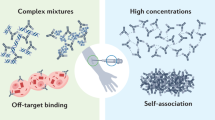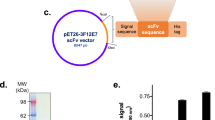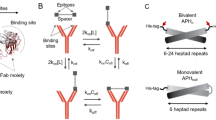Abstract
The use of monoclonal antibodies in cancer therapy is limited by their cross-reactivity to healthy tissue. Tumor targeting has been improved by generating masked antibodies that are selectively activated in the tumor microenvironment, but each such antibody necessitates a custom design. Here, we present a generalizable approach for masking the binding domains of antibodies with a heterodimeric coiled-coil domain that sterically occludes the complementarity-determining regions. On exposure to tumor-associated proteases, such as matrix metalloproteinases 2 and 9, the coiled-coil peptides are cleaved and antigen binding is restored. We test multiple coiled-coil formats and show that the optimized masking domain is broadly applicable to antibodies of interest. Our approach prevents anti-CD3-associated cytokine release in mice and substantially improves circulation half-life by protecting the antibody from an antigen sink. When applied to antibody–drug conjugates, our masked antibodies are preferentially unmasked at the tumor site and have increased anti-tumor efficacy compared with unmasked antibodies in mouse models of cancer.
This is a preview of subscription content, access via your institution
Access options
Access Nature and 54 other Nature Portfolio journals
Get Nature+, our best-value online-access subscription
$29.99 / 30 days
cancel any time
Subscribe to this journal
Receive 12 print issues and online access
$209.00 per year
only $17.42 per issue
Buy this article
- Purchase on Springer Link
- Instant access to full article PDF
Prices may be subject to local taxes which are calculated during checkout



Similar content being viewed by others
Data availability
The data that support the findings of this study are available within the paper and its Supplementary Information files.
References
Bugelski, P. J. & Martin, P. L. Concordance of preclinical and clinical pharmacology and toxicology of therapeutic monoclonal antibodies and fusion proteins: cell surface targets. Brit. J. Pharmacol. 166, 823–846 (2012).
Hansel, T. T., Kropshofer, H., Singer, T., Mitchell, J. A. & George, A. J. The safety and side effects of monoclonal antibodies. Nat. Rev. Drug Discov. 9, 325–338 (2010).
Polu, K. R. & Lowman, H. B. Probody therapeutics for targeting antibodies to diseased tissue. Expert Opin. Biol. Ther. 14, 1049–1053 (2014).
Desnoyers, L. R. et al. Tumor-specific activation of an EGFR-targeting probody enhances therapeutic index. Sci. Transl. Med. 5, 207ra144 (2013).
Donaldson, J., Kari, C., Fragoso, R., Rodeck, U. & Williams, J. C. Design and development of masked therapeutic antibodies to limit off-target effects: application to anti-EGFR antibodies. Cancer Biol. Ther. 8, 2147–2152 (2009).
Thomas, J. & Daugherty, P. Proligands with protease-regulated binding activity identified from cell-displayed prodomain libraries. Protein Sci. 18, 2052–2059 (2009).
Erster, O. et al. Site-specific targeting of antibody activity in vivo mediated by disease-associated proteases. J. Control. Release 161, 804–812 (2012).
Yang, Y. et al. Preclinical studies of a pro-antibody-drug conjugate designed to selectively target EGFR-overexpressing tumors with improved therapeutic efficacy. mAbs 8, 405–413 (2015).
Yang, Y. et al. Generation and characterization of a target-selectively activated antibody against epidermal growth factor receptor with enhanced anti-tumor potency. mAbs 7, 440–450 (2015).
Sandersjoo, L., Jonsson, A. & Lofblom, J. A new prodrug form of Affibody molecules (pro-Affibody) is selectively activated by cancer-associated proteases. Cell. Mol. Life Sci. 72, 1405–1415 (2015).
Chen, I. et al. Selective antibody activation through protease-activated pro-antibodies that mask binding sites with inhibitory domains. Sci. Rep. 7, 1–12 (2017).
Burkhard, P., Stetefeld, J. & Strelkov, S. V. Coiled coils: a highly versatile protein folding motif. Trends Cell Biol. 11, 82–88 (2001).
Thomas, F., Boyle, A. L., Burton, A. J. & Woolfson, D. N. A set of de novo designed parallel heterodimeric coiled coils with quantified dissociation constants in the micromolar to sub-nanomolar regime. J. Am. Chem. Soc. 135, 5161–5166 (2013).
Arndt, K., Pelletier, J., Müller, K., Plückthun, A. & Alber, T. Comparison of in vivo selection and rational design of heterodimeric coiled coils. Structure 10, 1235–1248 (2002).
Schmidt, M. M. Engineering antibodies for improved targeting of solid tumors. PhD thesis, Massachusetts Institute of Technology, Ch. 5 (2010); http://hdl.handle.net/1721.1/61239
McClain, D., Woods, H. & Oakley, M. Design and characterization of a heterodimeric coiled coil that forms exclusively with an antiparallel relative helix orientation. J. Am. Chem. Soc. 123, 3151–3152 (2001).
Plückthun, A. & Pack, P. New protein engineering approaches to multivalent and bispecific antibody fragments. Immunotechnology 3, 83–105 (1997).
Gerber, H. P. et al. Potent antitumor activity of the anti-CD19 auristatin antibody drug conjugate hBU12-vcMMAE against rituximab-sensitive and -resistant lymphomas. Blood 113, 4352–4361 (2009).
Jiang, T. et al. Tumor imaging by means of proteolytic activation of cell-penetrating peptides. Proc. Natl Acad. Sci. USA 101, 17867–17872 (2004).
Turk, B. E., Huang, L. L., Piro, E. T. & Cantley, L. C. Determination of protease cleavage site motifs using mixture-based oriented peptide libraries. Nat. Biotechnol. 19, 661–667 (2001).
Shay, G., Lynch, C. C. & Fingleton, B. Moving targets: emerging roles for MMPs in cancer progression and metastasis. Matrix Biol. 44–46, 200–206 (2015).
Kessenbrock, K., Plaks, V. & Werb, Z. Matrix metalloproteinases: regulators of the tumor microenvironment. Cell 141, 52–67 (2010).
King, K. M. & Younes, A. Rituximab: review and clinical applications focusing on non-Hodgkin’s lymphoma. Expert Rev. Anticancer Ther. 1, 177–186 (2001).
Maximiano, S., Magalhães, P., Guerreiro, M. P. & Morgado, M. Trastuzumab in the treatment of breast cancer. BioDrugs 30, 75–86 (2016).
Ryan, M. C. et al. Integrin αVα6 is expressed on multiple solid tumors and is a potential therapeutic target for auristatin-based antibody-drug conjugates. Canc. Res. 72, abstr. 4630 (2012).
Leo, O., Foo, M., Sachs, D. H., Samelson, L. E. & Bluestone, J. A. Identification of a monoclonal antibody specific for a murine T3 polypeptide. Proc. Natl Acad. Sci. USA 84, 1374–1378 (1987).
Lin, J. & Sagert, J. in Innovations for Next-Generation Antibody-Drug Conjugates (ed. Damelin, M.) 281–298 (Springer Int. Pub., 2018).
Doronina, S. O. et al. Enhanced activity of monomethylauristatin F through monoclonal antibody delivery: effects of linker technology on efficacy and toxicity. Bioconjug. Chem. 17, 114–124 (2006).
Stanková, J., Hoskin, D. W. & Roder, J. C. Murine anti-CD3 monoclonal antibody induces potent cytolytic activity in both T and NK cell populations. Cell. Immunol. 121, 13–29 (1989).
Alegre, M. et al. Hypothermia and hypoglycemia induced by anti-CD3 monoclonal antibody in mice: role of tumor necrosis factor. Eur. J. Immunol. 20, 707–710 (1990).
Ferran, C. et al. Cytokine-related syndrome following injection of anti-CD3 monoclonal antibody: further evidence for transient in vivo T cell activation. Eur. J. Immunol. 20, 509–515 (1990).
Huang, X. et al. Inactivation of the integrin B6 subunit gene reveals a role of epithelial integrins in regulating inflammation in the lungs and skin. J. Cell Biol. 133, 921–928 (1996).
Lyon, R. P. et al. Reducing hydrophobicity of homogeneous antibody-drug conjugates improves pharmacokinetics and therapeutic index. Nat. Biotechnol. 33, 733–735 (2015).
Acknowledgements
We thank our Seattle Genetics colleagues L. Benoit, D. Meyer and J. Mitchell for help with antibody–drug conjugation and C. Yu for help with internalization experiments.
Author information
Authors and Affiliations
Contributions
V.H.T., M.R.L. and P.D.S. participated in writing, reviewing and editing of the manuscript. V.H.T. and M.R.L. participated in the planning, initiation, data generation and analysis of biological experiments. V.H.T., X.Z. and M.R.L. performed cell-based assays. V.H.T. performed zymography experiments. S.W.W. and M.M.D performed biophysical characterization. J.H.C. conducted analysis of pharmacokinetics experiments. R.C.Y., W.Z., J.K.S. and I.J.S. performed in vivo anti-tumor activity and pharmacodynamics experiments. M.C.R., R.P.L. and P.D.S. provided project oversight and review.
Corresponding author
Ethics declarations
Competing interests
All of the authors were employees and shareholders of Seattle Genetics at the time of these studies.
Additional information
Publisher’s note: Springer Nature remains neutral with regard to jurisdictional claims in published maps and institutional affiliations.
Integrated supplementary information
Supplementary Figure 1 Representative size-exclusion chromatographs and expression titers for select antibodies.
Analytical size-exclusion chromatography (SEC) data was collected as described in the Materials and Methods.
Supplementary Figure 2 Protease cleavage of coiled-coil masked antibodies.
a) Representative characterization of coiled-coil masked antibodies and MMP activation by LC-MS. Shown is the deconvoluted spectra of CC2B-IPVSLRSG-rituximab heavy and light chains (top) as well as MMP-2-cleaved CC-IPVSLRSG-rituximab heavy and light chains (bottom) following reduced reverse-phase LC-MS. b) Representative data for the cleavage of CC3-IPVSLRSG-hBU12 with a panel of human (h) and mouse (m) MMPs. Activated MMP (6 Enzyme Units, EU, amount of enzyme to process 1 μg substrate/minute) was incubated with antibody (10 μg) at for 20 min at 37 °C. Reactions were stopped by addition of 25 mM EDTA and samples were analyzed using the method described in (A). The percent cleaved heavy or light chain was calculated using peak intensities from deconvoluted mass spectra. Two independent experiments were performed with similar results.
Supplementary Figure 3 Kinetics of antibody binding.
Kinetics of binding for hBU12 and CC2B-hBU12 were assessed via biolayer interferometry using recombinant human CD19. Biotinylated antigen was immobilized on a streptavidin-coated biosensor and antibodies were then assessed for association and dissociation over time. Kinetic parameters were determined using the Octet analysis software using a 1:1 global fit binding model. This experiment was repeated in two independent experiments with similar results.
Supplementary Figure 4 Binding of partially masked antibodies.
Half-masked hBU12 antibodies were assessed for binding on CD19(+) Raji cells. Antibodies were expressed containing an MMP-cleavable linker on either the heavy or light chain and a non-cleavable linker on the opposite chain. a) Characterization of LC cleavable CC2B-hBU12 constructs by reverse phase LC-MS. Shown is the deconvoluted mass spectra of LC-CC2B-hBU12 heavy and light chain (top) as well as MMP-2-cleaved heavy and light chain (bottom). The additional peak (*, 55922 Da) on the heavy chain is due to complexation of mercury from the activation buffer for MMP-2. Following incubation with MMP-2, the light chain containing the IPVSLRSG sequence was cleaved whereas the heavy chain containing the LALGPG sequence was not. Similar results were observed for HC CC2B-hBU12 except the heavy chain was cleaved whereas the light chain was not (data not shown). b) The half-masked antibodies were assessed for binding via saturation analysis on human CD19-expressing Raji cells using flow cytometry. Data represent the mean of duplicate cell samples. Half-cleaved antibodies restored binding to within approximately 10-fold of the parent antibody whereas fully cleavage restores binding to the same level as un-masked hBU12. For S4B, two independent experiments were conducted with similar results.
Supplementary Figure 5 Proliferation of mouse T cells in the presence of either masked or unmasked anti-mouse CD3 antibodies.
Mouse T-cells were labeled with carboxyfluorescein succinimidyl ester (CFSE) and incubated with either CC2B-masked or unmasked anti-mouse CD3 antibodies at 500 ng/mL along with anti-CD28 stimulation at 37 °C. T-cell activation was monitored after 4 days of incubation using flow cytometry. A leftward shift of fluorescence indicates that CFSE has been diluted as cells have proliferated. Robust proliferation was observed for the anti-mouse CD3 antibody whereas no proliferation occurred for the masked antibody. Two independent experiments were conducted with similar results.
Supplementary Figure 6 In situ zymography of frozen Ramos xenograft tumor slices.
Protease activity was assessed by incubating Alexa Fluor 647-labeled hBU12 or CC3-IPVSLRSG-hBU12 antibodies (1 µg/mL) with fresh frozen Ramos tumor slices (5 µm). Proteolysis of the mask results in binding of the antibody, as detected using an Olympus fluorescence microscope. The addition of protease inhibitors resulted in reduced binding of CC3-IPVSLRSG-hBU12, whereas hBU12 binding was not impacted. Images were taken at 20x magnification and the scale bar indicates a 50 μm distance. Two independent experiments were conducted with similar results.
Supplementary Figure 7 Binding of masked and unmasked h15H3-gluc-MMAE(8) ADCs.
Binding was assessed by saturating binding on αVβ6-transfected human embryonic kidney (HEK) cells. Data represent the mean of duplicate cell samples. For the cleaved antibody, the CC2B mask was removed via recombinant MMP-2, which was confirmed by reverse-phase LC-MS analysis prior to the binding study. Two independent experiments were performed with similar results.
Supplementary Figure 8 Cytotoxicity of masked and unmasked h15H3-gluc-MMAE(8) ADCs.
ADCs were incubated with BxPC3 cells for 96 h at 37 °C. Cytotoxicity was assessed using CellTiter-Glo (Promega) and luminescence was measured on an EnVision plate reader (Perkin Elmer). Data represent the mean ± s.d. of quadruplicate cell samples. Two independent experiments were performed with similar results.
Supplementary Figure 9 Efficacy of anti-αVβ6 h15H3-gluc-MMAE(8) ADCs in Detroit-562 xenograft.
Mice were administered a single 3 mg/kg IP dose once tumors reached 100 mm3 and tumor size was measured at various time points. Data represent the mean of n = 5 biologically independent animals. The experiment was performed once, but the h15H3-gluc-MMAE(8) ADC has been tested in at least one additional independent experiment and provided similar results.
Supplementary Figure 10 Efficacy of anti-αVβ6 h15H3-gluc-MMAE(8) ADCs in HPAF-II xenograft.
Mice were administered a single 3 mg/kg IP dose once tumors reached 100 mm3 and tumor size was measured at various time points. Data represent the mean of n = 5 biologically independent animals. The experiment was performed once, but the h15H3-gluc-MMAE(8) and isotype ADCs have been tested in at least one additional independent experiment and provided similar results.
Supplementary Figure 11 Cleavage of masked ADCs in vivo.
Western blot analysis of tumor, plasma, and liver samples from an HPAF-II xenograft tumor model. Mice bearing HPAF-II tumors (100 mm3) were dosed with 3 mg/kg of CC2B-h15H3-gluc-MMAE(8) ADCs bearing either cleavable (PLGLAG) or scrambled (LALGPG) cleavage sequences, or the h15H3-gluc-MMAE(8) parent ADC. At 4 days post-dose, mice were sacrificed and tissues were harvested. Antibody was purified from homogenized tissue samples using protein A capture and the presence of intact or cleaved antibody was assessed via western blot. The experiment was conducted once with n = 3 mice for CC2B-PLGLAG-h15H3, n = 2 mice for CC2B-LALGPG-h15H3, and n = 3 mice for h15H3.
Supplementary Figure 12 In situ zymography of frozen HPAF-II tumor slices.
Protease activity was assessed via incubation of anti-αVβ6 CC2B-h15H3 antibodies with HPAF-II tumor slices. Proteolysis of the mask results in antibody binding, which was detected using an AF594 labeled anti-human secondary antibody. The scrambled control antibody CC2B-LALGPG-h15H3 was less effectively cleaved than the cleavable antibody CC2B-IPVSLRSG-h15H3, as indicated by reduced staining of the tumor slice. Images were taken at a 10x magnification and the scale bar indicates a 100 μm distance. Two independent experiments were performed with similar results.
Supplementary Figure 13 Partial MMP cleavage and binding analysis of CC2B-PLGLAG-h15H3.
100 μg of antibody was incubated with 9 EU of human MMP2 at 37 °C for 0, 5, 10, 40, and 60 min. The reaction was stopped at the indicated times using 25 mM EDTA and samples were analyzed using reduced reverse-phase LC-MS. The percent cleaved antibody was calculated using mass spectrometry peak intensities and represents an average of heavy and light chain cleavage. Binding was assessed using human embryonic kidney cells (HEK) expressing αVβ6. Data represent the mean of duplicate cell samples. Two independent experiments were performed with similar results.
Supplementary Figure 14 Cleavage of non-binding antibodies in vivo.
Cleavage analysis of CC3-masked non-binding antibodies in the plasma of naïve BALB/c (left) or HT1080 xenograft-bearing nude mice (right). Naïve BALB/c mice were dosed with 3 mg/kg of a CC3-IPVSLRSG-masked IgG1 isotype control antibody (left) and HT1080 tumor-bearing nude mice dosed with 5 mg/kg of CC3-IPVSLRSG-IgG1 (right). At the times indicated, plasma samples were collected from mice, human antibodies was captured using protein A resin, and the presence of intact or cleaved antibody heavy chain was assessed via Western blot. Data represent the mean ± SD (n = 3 biologically independent animals). Two independent experiments were performed with similar results.
Supplementary information
Supplementary Information
Supplementary Figs. 1–14 and Supplementary Tables 1 and 2
Rights and permissions
About this article
Cite this article
Trang, V.H., Zhang, X., Yumul, R.C. et al. A coiled-coil masking domain for selective activation of therapeutic antibodies. Nat Biotechnol 37, 761–765 (2019). https://doi.org/10.1038/s41587-019-0135-x
Received:
Accepted:
Published:
Issue Date:
DOI: https://doi.org/10.1038/s41587-019-0135-x
This article is cited by
-
Exploring the next generation of antibody–drug conjugates
Nature Reviews Clinical Oncology (2024)
-
Designed allosteric protein logic
Cell Discovery (2024)
-
Hierarchical functional nanoparticles boost osteoarthritis therapy by utilizing joint-resident mesenchymal stem cells
Journal of Nanobiotechnology (2022)
-
Turning antibodies off and on again using a covalently tethered blocking peptide
Communications Biology (2022)
-
De novo design and directed folding of disulfide-bridged peptide heterodimers
Nature Communications (2022)



